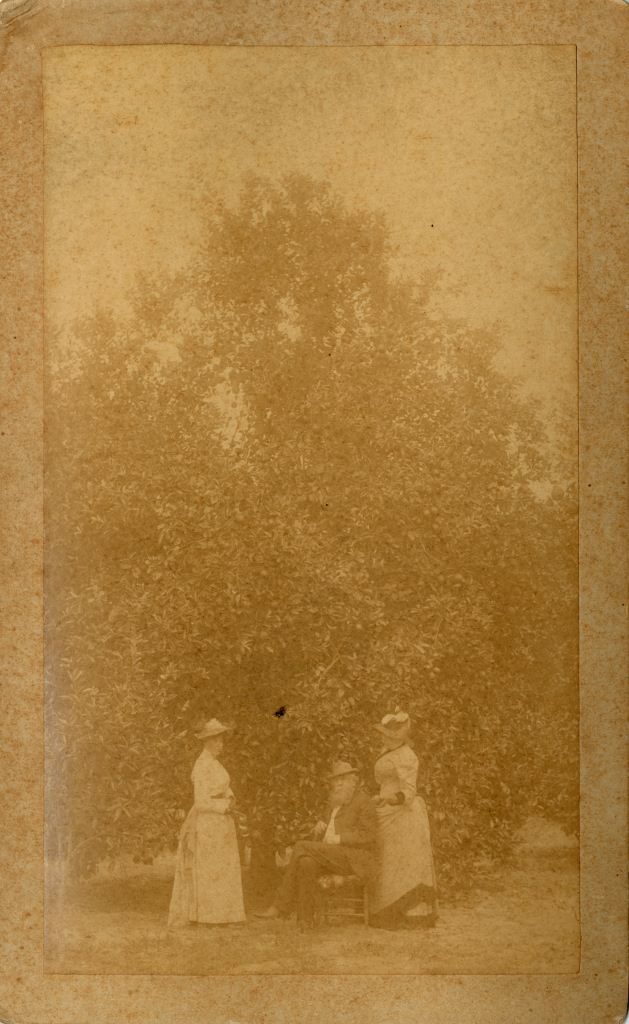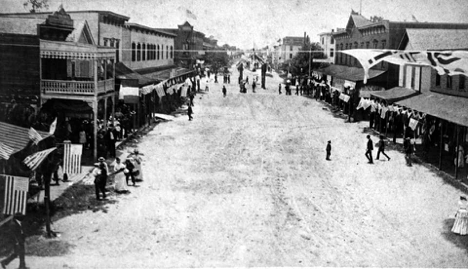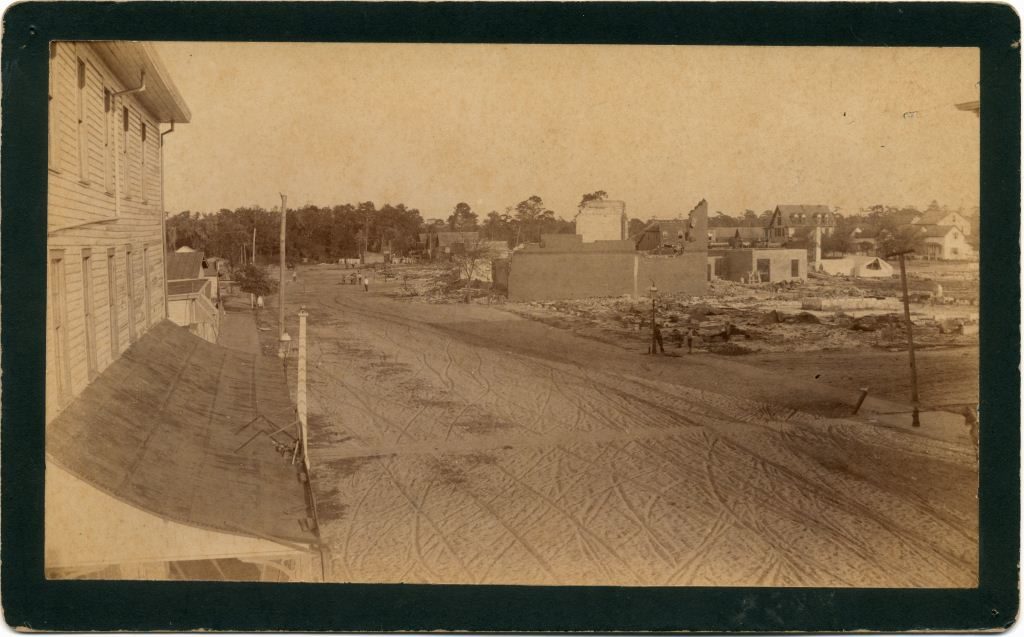
The Sanford Avenue church was a large building with a very steep roof. Among the early members was Judge J. Wofford Tucker who was also known as the arbiter in all controversies and often led the services and prayer meetings.
The story of the church states that there were ten members of the choir and that the church boasted of an organ. Mrs. C.H. Leffler played the organ until the arrival of Mr. Mettinger, who then became the organist as well as the superintendent of Sunday school for the next thirty years. Mrs. Mettinger became the choir director and remained in this position for sixteen years.
When the church on Sanford Avenue was finished, it was without furnishings of any kind. Through the efforts of some of the ladies in the church, pulpit furniture was secured from an Orlando firm. It has been remembered that this furniture was moved with the church to the Park Avenue location.
The Florida Conference of the Methodist Episcopal Church (South) made Sanford a Charge Station in 1884; assigning Rev. C.A. Saunders as the first pastor. Most of the members of the Ernest Chapel had, by this time, transferred their membership to the Methodist Church in Sanford.
Bishop H. H. Kavanaugh, arriving by boat on a Saturday afternoon, visited Sanford in 1884. He was met by Judge Tucker who entertained the Bishop in his home during his stay. Upon seeing the newly constructed church, The Bishop noticed there was not a platform or a pulpit in the church, and, being of small stature, he was distressed and declared that he would not be able to preach without a platform on which to stand. The alarmed and disturbed Rev. Saunders hurried to get help. Dr. Phillips, a local druggist in town and member of the church, Rev. Saunders, and Dr. Phillips’ helper worked during the night making a platform for the Bishop and installed it in time for services Sunday morning. The Bishop preached one hour and twenty minutes to an overflow congregation. Some had camped on the church grounds all night, having traveled a long distance to hear the Bishop.
The site of the first parsonage for the church, located on the corner of 7th Street and Magnolia Avenue, was bought in 1887. A group of women of the church had socials, picnics, and other events to help pay for the property which cost $475.00. The parsonage constructed at this site (currently 618 Magnolia Ave.) served the ministers as their home until it was sold in 1964.
Happening in Sanford
For many years, General Sanford worked to establish a thriving citrus industry on his thousands of acres of property in Sanford.

“Florida’s modern citrus industry traces its roots to the Valencia oranges introduced first in Florida by city founder Henry Shelton Sanford and Swedish immigrant Carl Leonard Vihlen. Vihlen, a botanist, came from Sweden on a visit and fell in love with Emma Enroth, an earlier Swedish immigrant to the colony at New Upsala. They married, and Vihlen worked at Sanford’s Belair Groves.”¹
Belair Groves was located 3 miles southwest of the city, near the area of Bel-Air Lake, west of the 417 and south of H.E. Thomas Road. Many of the Swedish immigrants settled nearby in order to work on the groves. This area became known as Upsala (modern-day New Upsala) and many of the roads in this area are named for citrus as well as prominent names from this era (Vihlen Road).
“His (Sanford) chief contribution to the modern citrus industry, though, was his effort to expand the market for Florida-grown citrus. He was the first to have his fruit wrapped in tissue paper and shipped in crates by rail to avoid the spoilage that often occurred when citrus was shipped in barrels by boat.
The Florida Citrus Mutual credits Sanford and his Swedish botanist Vihlen with developing the Valencia orange, the basis of today’s concentrate business…Central Florida was once the largest shipper of oranges in the world, and thousands of groves prospered.”²
“The Sanford of the 1880s boasted two banks, eight churches, a public library, two schools, 30 businesses, and four newspapers. Three piers along Lake Monroe served commercial steamboats. A nearby railroad station was the terminus of the South Florida Railroad.

Henry Sanford’s Florida Land and Colonization Co. was encouraging investment in the new city, which had become a distribution point. Sanford had developed into a hub for goods arriving for the growing Central Florida communities, and citrus and other produce shipped to Northern markets.
However, a disaster was to change the face of Sanford. In the early morning of Sept. 22, 1887, a First Street bakery caught fire. The blaze spread to the wooden buildings on the east side of town.”³

Approximately 30 businesses burned in the fire and it caused around $300,000 in damage, which would be about $8,000,000 in today’s value.4 As the city began to rebuild, most of the buildings were rebuilt using brick, giving the city its signature look. Many of these brick buildings still stand in downtown to this day. 5
Happening in the World
1884 – France incorporated Vietnam into its empire. American insurance salesman, Louis Waterman, created a fountain pen that’s not supposed to leak.
1885 – The Statue of Liberty was made in France; shipped to New York and placed onto Liberty Island in New York Harbor. The Washington Monument was dedicated and George Eastman created modern film technology.
1886 – Karl Benz patented his first automobile with an internal combustion engine. John Pemberton began selling his formula ( a mixture of cocaine and caffeine) at a pharmacy in Atlanta. It was initially sold as a patent medicine for a nickel a glass at soda fountains. Coca Cola no longer contains cocaine but that’s how it got its name.
1887 – Earmuffs were patented. The first American Golf Club was organized in Foxburg, PA. The Yellow River in China burst its banks, killing 900,000.
1888 – The National Geographic Society was founded. George Eastman invented the Kodak #1Box Camera. Scottish inventor John Boyd Dunlop patented the first practical pneumatic or inflatable tire.
1889 – The Eiffel Tower was opened in Paris. The Oklahoma Land Rush began at noon on April 22nd. On May 31st, the South Fork Dam located upstream from Johnstown, PA failed causing the great Johnstown Flood. Four states joined the union: North Dakota (39), South Dakota (40), Montana (41), and Washington (42).
- “Coming Full Circle: Citrus Heads Home East” Orlando Sentinel Article by Jim Robinson. January 23, 2000. Accessed at: https://www.orlandosentinel.com/news/os-xpm-2000-01-23-0001210322-story.html
- Ibid.
-
”1887 FIRE CHANGED SANFORD” by Jim Robinson. Orlando Sentinel printed July 26, 1990. Accessed at: https://www.orlandosentinel.com/news/os-xpm-1990-07-26-9007260395-story.html
-
Businesses and damage founding newspaper article from The Pensacola Commercial, September 23, 1887. Accessed at https://www.newspapers.com/clip/22417925/sanford-fire-sept-1887/. Inflation of value calculated at https://www.in2013dollars.com/us/inflation/1887?amount=300000
- For a map and brochure from the Sanford Historic Preservation Board, check out: https://www.sanfordfl.gov/home/showdocument?id=18076
Picture of BelAir Groves above accessed at https://richesmi.cah.ucf.edu/omeka/exhibits/show/origins_of_the_celery_city/item/701